Maybe you should join a Bicycle Club?
Maybe you should join a Bicycle Club?
Maybe you would like to ride in company of others, be part of a network of cycling friends, or simply have a group to socialize with. If so, you may want to consider joining a bicycle club.
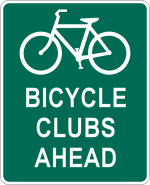
Before going any further, it should be clarified that club membership is by no means a prerequisite for making extensive use of your bike, and it may not be all that relevant for people who use their bicycles primarily for basic transportation or to commute to work.
Nevertheless, there’s a lot to be said for joining a club when comes it to discovering new routes and destinations, planning and organizing multi-day touring trips, or having some friends to sit with in a coffee shop at the end of a ride. Moreover, the collective expertise of a club quickly disseminates among its members, providing everyone with valuable information about cycling techniques, bicycle repair, the best equipment, and so on.
This article is aimed at people who may be thinking of joining a club for the first time, view themselves as beginners or intermediate cyclists, and are generally interested in road cycling, including recreational rides, training rides, and maybe some touring trips. While these activities are the focus of many bicycle clubs, be aware that there are also some that cater almost exclusively on competitive cycling or off-road biking.
Choosing the right club
When looking for a club, don’t sign up with the first one you come across, and hope for the best. Do a little research to find one that is best suited for your type of cycling. Otherwise you could end up feeling out of place in a club where everyone likes to pedal hard and go long distances, or become frustrated with group rides that proceed at a very relaxed pace. (There is a list of local clubs at the end of this article.)
The easiest way to learn more about a bicycle club is to check out their website or Facebook page. The first thing to do is see if a club caters to people who like leisurely rides, endurance/training rides, bicycle touring, time trials and racing, or any combination of the foregoing. Next, examine the “difficulty levels” of the club’s rides to find out if there is one that’s suitable for you. While you’re at it, review the club’s calendar or schedule to see if they actually offer a reasonable number of rides in the “difficulty level” that interests you.

A group ride takes a short break next to one of the pathways.
It’s also a good idea to try to figure out a club’s approach to group rides. Some favour a more disciplined or structured style where people cycle in tighter groups or pacelines. These clubs sometimes require that new members get checked out or that they take a short course on how to ride in a group. With other clubs, people cycle in loose groups, with more space between one another. The latter makes for a more relaxing ride, but a paceline makes it makes easier for everyone when cycling into a strong headwind.
Clubs often have one or two fixed or permanent “starting points” for many of their weekly rides. It’s nice to be able to get to these starting points by bike, so check to see if they are in easy pedalling distance from your home.
Get an idea of the club’s size and demographics. This is sometimes stated explicitly, other times it’s only implied. The membership at larger clubs often have a range of different age groups, while smaller clubs tend to attract members from a particular cohort, such as aging baby boomers. Smaller clubs often have a milieu that is a little less formal and where everyone gets to know each other, while larger clubs usually offer more activities and give you more choices about who you’ll ride with.
You also gain some useful information by perusing the photo galleries on a club’s website. Studying the photos will give you a good idea of the age of club members, and the type of bicycles and equipment they use. Just remember that such photos may not always be representative of the entire club and all of its activities.
A closer look at club (group) rides
Since group rides are at the heart of what most clubs are about, it’s worth taking a closer look at what is being offered. This can be especially important for those individuals who may wonder if they have the capacity to keep up with a group ride.
Many clubs rate their rides according to various difficulty levels on a scale of 1 to 3, or 1 to 4, etc. The easiest tend to be fairly short and relatively slow rides that have a good number of rest stops, and generally take place over flat terrain. The difficulty levels gradually ratchets up until you get to the most challenging rides. These can be quite fast, with some having no upper speed limit. They will appeal to people who like to cycle longer routes that can include hilly terrain.
Level |
range |
|
Very easy |
km/h |
Typical distance of 30 to 40 km, mainly flat route (often on bike paths), frequent rest stops. |
km/h |
Typical distance of 40 to 50 km, mostly flat route with the occasional small hill, numerous rest stops. | |
(not too hard) |
km/h |
Typical distance of 50 to 70 km, some hills (but nothing too serious), regular rest stops. |
(a little harder) |
km/h |
Typical distance of 60 to 80 km, some rides can be a bit hilly, some rest stops. |
difficult |
km/h |
Typical distance of 70 to over 100 km, can be very hilly, only a few rest stops. |
& difficult |
34 km/h |
Typical distance of 80 to 160 km, can be very hilly, very few rest stops. |
|
Note: This is a very rough example of difficulty levels for group rides. Clubs will usually have fewer difficulty levels than in the example, and there are overlaps in the speed ranges given because each club has its own way of demarcating the speeds for different levels.
|
||
|---|---|---|
Each difficulty level is usually described by the effort it takes to pedal in a specific speed range when cycling on a relatively flat terrain with no significant wind. Speeds would decrease when pedaling up up a slope or against a headwind, and would increase when descending a hill or cycling with a tailwind. The length will vary from 30 to 50 kilometres for the easier rides, to well over 100 kilometres for the more difficult rides.
For people who worry about their ability to keep up, it should be noted that at many clubs, the easier and mid level outings are often treated as “no drop” rides (where the group does not abandon or “drop” someone who is struggling to keep up). When needed, the ride leader will usually slow things down a little and/or initiate more rest stops. It should also be remembered that there’s a longer rest stop at the mid-point of many rides, including the more difficult ones. These are often lunch stops where people can have a picnic, grab a bite to eat at a sandwich shop, or even sit down for a meal in a country pub.
Clubs typically offer a good selection of rides at different difficulty levels on weekends. Many will begin at a fixed starting point in town, but some will be designated as “remote start” rides. These require that you use a car to bring your bike to a starting point outside the city, but they allow you to explore roads and see areas that would otherwise be out of reach for a day ride starting in the city.
Some clubs also offer regular evening rides on a weekday. These usually start around 6:00 pm and last one to two hours, depending on the amount of daylight available and the difficulty level of the ride. Evening rides are sometimes followed by a meal and social get together at a local pub. A few clubs whose membership includes a large number of retired people may also schedule a couple of daytime rides on weekdays.
And finally, it’s worth noting that some clubs will supply a cue sheet that provides turn by turn directions for the route for certain group ride. The cue sheet is sometimes accompanied by a basic map, and a paper version may be handed out by the ride leader, or digital versions may be made available on the club’s website for downloading and printing. In addition, a growing number of clubs are making digital routes available that can be loaded into a GPS unit.
Multi-day tour rides
One of the benefits of joining a club is being able to participate in its cycle tours (multi-day bicycle trips). Some can be local weekend getaway trips, while others can involve longer tours in more distant locations in North America or even Europe. Whatever the case, these types of rides open all sorts of new vacation and adventure opportunities, and allow you to discover small villages, secluded vistas, or hidden beaches that often go unnoticed from the major highways.
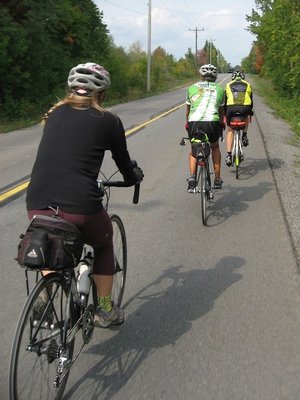
A group ride on a quiet country road near Ottawa.
Examples of local trips include a ride along the Lake Ontario’s waterfront and through vineyards of the Picton area, or the easy to ride “P’tit train du Nord” trail that winds its way through the Laurentians north of Montreal. More distant trips might include pedaling around the Niagara Peninsula, cycling the sometimes arduous Cabot Trail in Cape Breton, or a laid back ride across Price Edward Island. Some clubs will organize trips in places like California or oversea destinations such as Holland or southern France.
Participating in a tour organized by a club means you’ll probably know most of the people you’ll be cycling with (and sharing a room with), something that is not always possible with a commercial tour operator. You’ll also be better able to gauge the difficultly level of the trip and avoid finding yourself with a group that’s horrendously slow, or insanely fast. Furthermore, by pooling resources and keeping costs to a minimum, these trips tend to be less expensive than what is available commercially.
On most club tours, people stay at inexpensive motels, B&Bs, or even low cost university residences, which are devoid of students during the summer. Sometimes people have to transport their own clothing and toiletries in pannier bags (which can be kept to a minimum with careful packing). However, if the group is large enough, there is often a support vehicle (a SAG wagon) that is used to move everyone’s luggage from one destination to the next, and that may also be available to pick up anyone that runs out of steam.
Many club tours are organized so that there will be a slower and faster group, or in some cases, people naturally break into such groups. Regardless of what happens, at the end of the day everyone gets together for post-ride refreshments and a well deserved meal.
Multi-day “hub-and-spoke” rides are popular with many clubs and provide an alternative to the traditional tours where everyone travels to a new destination each day. With hub-and-spoke rides, everyone stays at a central location, usually a small town (the hub) that is surrounded by lots of quiet country roads (the spokes). Each day the group rides a different route that loops back to where they are staying.
Hub-and-spoke rides are relatively simple to organize and allow people to see new countryside without having to pack up and move to a new destination each day. They also make it much easier for the ride organizers to offer people a choice between shorter easier routes and longer, more difficult ones. And because the group operates out of the same home base for the entire trip, it’s no problem if someone sits out a day if they are getting a little tried.
Bicycles for club rides
All you really need is a reasonable quality multi-speed road bike to join most clubs. This include models with straight or flat handlebars that are often labeled as hybrid, fitness, or recreational bicycles. Drop bar models are also very popular at many clubs. These have the handlebars that curve down (drop bars) and that some people associate with racing bikes. There is usually a good mix of both types of bicycles in the easier club rides, while drop bar models are common in the faster more difficult rides.
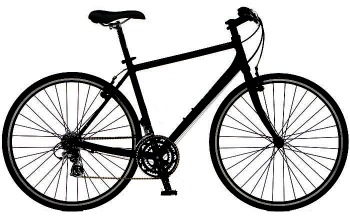
Bicycle with straight or flat handlebars.
People who are just starting to get seriously involved in cycling often believe that drop bar models are thoroughbred racing machines that require people to ride in a low position bent over the handlebars. However, drop bars are also found on bicycles with a “relaxed geometry” that provide people with a more upright riding position, similar to that on many flat bar models. With these bikes, the top of the drop bars are at the same height, or slightly higher, than the saddle.
People like these bikes with a relaxed geometry because drop bars provide more hand holding positions, something that can provide additional comfort on longer rides. They also allow you to use the lower part of the handlebar to get into a more aerodynamic position when riding into a strong headwind, or when, heaven forbid, racing to catch a friend who has somehow managed to pull ahead of you (yes, these little competitions can sometimes happen among friends, even on nice leisurely rides).
Whatever the case, many people do not see themselves riding bicycles with drop bars, and they will do fine with flat bar models on slower and mid-level rides. Ideally, these bikes will have solid (non-suspension) forks and be fitted with tires that are 25, 28, or even 32 mm wide. These are often marketed as fitness or training bicycles. If you will be participating mainly in easier rides, you could use a more traditional hybrid bicycle with front fork suspension and slightly wider tires. However, these bikes tend to be a bit heavier and their wider tires may generate a little extra rolling resistance that may become noticeable on longer rides.
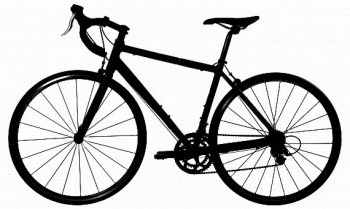
Bicycle (relaxed geometry) with drop bars.
One type of bike you may want to avoid is a very plush hybrid that comes with a heavy frame, lots of suspension, and overly wide tires. These bikes are designed for short sedate rides around your local neighbourhood, and they will suck a lot energy out of you on longer rides. This can start to make it difficult for some people to keep up with the group (even on easier rides).
On the other hand, there is one type of bike that you absolutely must have for participating in club rides. It’s a bicycle that’s in good working order. Fellow clubs members are usually very happy to stop and help someone who has a flat tire or mechanical problem, but they may soon become annoyed if they realize the ride is being interrupted because of someone’s poorly maintained bike or worn out tires. While your bike doesn’t have to be particularly new or expensive, it has to be properly maintained. And because road bike tires start to loose pressure after a couple of days, don’t forget to keep them pumped up.
Equipment & Accessories for club rides
Basically, you’ll need all the items you normally bring when cycling. This includes an extra inner tube, tire levers, a good quality compact air pump, and at least one water bottle and water bottle cage ( preferably two on hot days). When heading out on an evening ride, bring rear and front bicycle LED lights in case you find yourself on the road as the sun is setting (lights are legally required a half hour before sunset).
For yourself, you’ll need a helmet, as wearing one is a requirement with just about all clubs. Sunscreen and sunglasses will make cycling more enjoyable, and it’s always a good idea to carry one or two energy or granola bars in case you need to refuel in an area where there’s no place to stop to buy a snack.
A cell phone is almost indispensable, and will come in handy for emergencies or if you somehow manage to become separated from the group. While you may be able to get by without one, an inexpensive bicycle computer can very helpful to track your speed and distance covered. If you want to splurge on something extra, you can get a GPS unit designed for cycling. Sometimes the route for a club’s ride is available to load onto a GPS, and this will allow you to see a map of the route, and track your progress in real time (an expensive toy that can be fun, but isn’t really needed with most club rides).
People who like to go fast on light-weight carbon bicycles usually find a way to bring everything they need in a tiny pouch under their saddle or in pockets on the back of their cycling jerseys. Almost everyone else will look for an easier way to carry things. For many people, this means installing an inexpensive aluminum rack over the rear wheel, and velcroing a “trunk” type bag on top of it. These rack-top bags have plenty of room for a jacket, snacks, phone, camera, maps, tube of sunscreen, and whatever else you might want to bring on your ride.
And finally, there is one more thing you’ll need to go on club rides, but it’s not a tangible item. It’s good “bike-fit”. This doesn’t only mean a proper size bicycle. It also means that handlebar and seat height, as well as other adjustments, have to be right, or you could end up suffering some aches and pains on longer rides. Getting good basic bike-fit isn’t rocket science, but it’s something you should pay attention to, especially if you’re going to be spending more time on your bike.
Bicycle clothing & shoes
It’s worth emphasizing that you don’t need any special clothing when going out for relatively short rides around the neighborhood. However, club rides tend to be a little longer than this, so you should have appropriate clothes. You could go out and buy expensive cycling jerseys and tight Lycra shorts, but you’ll do fine with garden-variety sportswear. Such clothing is made of synthetic material that is fast drying and breathable, and helps keep moisture away from your body. Generic sportswear can be found at reasonable prices, and you may already have what you need in your closet. Whatever the case, try to avoid any cotton clothing, including cotton socks and underwear.
When looking at what you might wear, pay particular attention to those areas where you will be in direct contact with the bike, namely your hands, feet, and posterior. Padded cycling gloves are inexpensive and help prevent hand numbness on longer rides. When using running or sports shoes for cycling, look for a pair with the stiffest soles that you can possibly find. 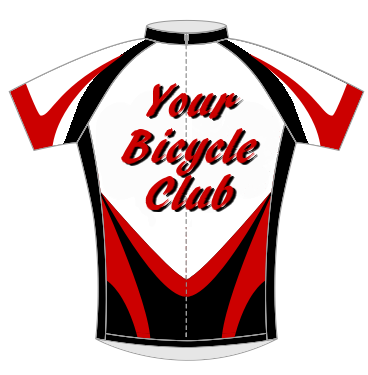 This will help keep your feet comfortable by distributing the load of your down stroke evenly over the entire pedal surface.
This will help keep your feet comfortable by distributing the load of your down stroke evenly over the entire pedal surface.
You may notice that cycling-specific shorts have a layer of padding (called a chamois) sewn in around the crotch and posterior areas. This can provide a significant degree of extra comfort when in sitting on the saddle for long periods. If tight Lycra shorts are not to your liking, consider a pair with a baggy outer shell, which look more like normal everyday shorts. Another option is cycling liner shorts (cycling underwear) which have a built-in chamois. These can be used under your regular everyday (non cotton) shorts. Cycling liner underwear can sometimes be difficult to find, so you may have to look for them online or at larger bike shops or sports stores (MEC may have some at reasonable prices).
Most bicycle clubs have their own line of custom clothing that is imprinted with their logo and colours. After you have been a member for a while, you might consider ordering a club jersey. It’s a fun way to display your affiliation and show off your club’s colours. Such jerseys can also be handy for special occasions – for example – when members of the same club decide to cycle together in charity fund raising rides.
Bicycle Club Riding Skills
Basic bike riding skills are all your really need to join a club, especially if you will be participating mainly in slow to mid level rides with a loose formation. People who are just getting started in cycling, or who haven’t ridden in years, may want to practice on their own before signing up, but it shouldn’t take too long to acquire the basic skills.
You should also be reasonably comfortable riding on roads with traffic. Most clubs will try to avoid very busy roads when planning their routes, and some of the easier rides may take place almost exclusively on bike paths and very quiet residential streets. Nevertheless, you should expect to do some riding on roads with light, and occasionally, moderate traffic, particularly on longer rides. If this worries you, a club is a great place to get used to this for two reasons. First, a group is more visible to motorists than someone riding solo, and secondly, in many cases, you’ll be in the company of some experienced cyclists who know what to expect on these roads.
Although basic riding skills are all you need to join, there are a few thing you’ll have to keep in mind when riding with a club. First and foremost, you always have to be aware that you’re riding in a group. This means no sudden or unpredictable moves or change in speed (e.g. no abrupt stops to take a photo when a nice scene pops into view). While this precaution is critical when cycling in tight paceline, it also applies to groups that are more loose or relaxed in their riding style.

Members of a bicycle club stop to have lunch next to the Rideau Canal.
You should also be predictable by riding in a steady straight line. Although they may not always notice it, many people tend to weave from side to side as they cycle in a given direction. It’s a question of making a best effort to avoid this. Likewise, try to keep your bike moving in a straight line when looking back to see what is behind you. Most people inadvertently steer their bicycles towards the side on which they are conducting their shoulder check.
For obvious reasons, it’s very important that there be clear communication within the group about any maneuvers or change in pace. This is usually done with hand signals for such things as coming to a stop, approaching a turn, or pointing out any dangers on the road. With most clubs, you’ll do fine with about a half dozen signals, half of which you probably already know, the other half being very intuitive and easy to remember. (They are illustrated at the end of this article.)
Each person riding in a group should repeat any signal that is made to ensure everyone behind can see what’s happening and no one is caught by surprise. For example, if the person at the front of the group signals that they are coming to a stop, everyone behind him or her should make the same signal.
Although hand signals form the basis for communication within a group, when necessary, you should also be prepared to use your voice to let people know what’s happening. Examples include yelling out in a clear voice “STOPPING”, “SLOWING”, “HOLE”, and so on. This can be handy in those instances when your hands are busy applying the brakes or holding the handlebars to control the bike when cycling over a rough surface.
Other considerations when joining a club
There are a few other thing you might want to consider when looking for a bicycle club to join.
Most clubs (not all) have third party liability insurance for their activities. This is often arranged through a provincial cycling association, but is sometimes provided directly through commercial insurance companies.
There are some clubs that allow for “Guest Riders”, but this is far from universal. If you are considering joining one of these clubs, you could check things out as a guest rider. You’ll have to look up their policy on what’s required to be a guest rider, but generally you’ll have to sign a waiver form to let the club know you’re coming. One of the benefits of being a member of a club that allows guest riders is that you can invite a friend along for one of the group rides. This can be particularly handy if an out-of-town cycling friend happens to be visiting for the weekend.
Another advantage of being a member of a bicycle club is that, in many cases, you’ll be eligible for discounts at certain stores and bike shops. This generally involves a 10% discount on things such as repairs, parts, accessories, and clothing (the details are usually posted on the a club’s website). A 10% discount may not seem like much when purchasing a tube or patch kit, but it can add up when it comes time to replace your bicycle’s tires, chain, saddle, and so on, or if you start updating your cycling wardrobe.
Non-cycling social activities is another area that shouldn’t be over looked. Barbeques or picnics are common activities during the cycling season, and in the winter months, many clubs organize Christmas parties, social get togethers at restaurants or pubs, snowshoe or cross-country ski outings in places like Gatineau Park. To learn more about a club’s social activities, look at the events or activities section of their website or Facebook page. Whatever the case, social activities provide a great way to stay in touch with cycling friends during the off-season.
And finally, there is the cost of joining a bicycle club. However, this may not be a major consideration since membership fees are very affordable, and are typically many times less than the cost of joining a golf club, tennis, or sailing club. Generally, the price of a single adult membership ranges from $30 to $75 a year (as of 2017), although the cost for some specialty clubs (racing or women-only clubs) can be quite a bit higher. There can be discounts for youth, additional family members, returning members, and so on. In most cases, the price of membership will provide you with access to all the clubs’ group rides and regular activities, but there can be some extra fees for participating in special events or multi-day tour rides.
When looking at costs, it’s important to make a distinction between those clubs that have insurance coverage and those that don’t. A number of clubs get their insurance through the Ontario Cycling Association (OCA), but this costs approximately $40 per member. In other words, a club may need $30 to fund its operation and activities, but the total membership bill will jump to $70 with the addition of the OCA insurance. Needless to say, membership fees will be considerably lower for clubs that don’t have their own insurance coverage.
Below is a list and short description of local bicycle clubs in the Ottawa-Gatineau area followed by hand signals typically used in groups rides.
Michael McGoldrick
April, 2017
[feather_share]
List of local clubs (Ottawa- Gatineau area)
The Ottawa Bicycle Club is one of the oldest and largest in Canada, with over  1100 members. Not surprisingly, it’s by far the largest club in the Ottawa-Gatineau area, and because of its size, it has something for everyone.
1100 members. Not surprisingly, it’s by far the largest club in the Ottawa-Gatineau area, and because of its size, it has something for everyone.
The OBC offers rides for all types of riders at all levels of ability. This includes group rides at different levels ranging from easy and relatively slow (ramblers) all the way to extremely fast with no upper speed limit (Sportif). It also holds weekly time trials (racing against the clock) to help cyclists improve their performance, and hosts a number of competitive events. The club organizes a various of multi-day tours in central Ontario, Quebec, and the north-eastern US, the most famous being the Rideau Lakes Cycle Tour (RLCT) from Ottawa to Kingston, and back. On top of all this, OBC arranges monthly social evenings where a guest speaker makes a presentation on topics of interest to cyclists.
OBC tends to emphasize a more structured approach to groups rides, and new members are expected to complete a half-day clinic on group riding techniques regardless of their cycling skills.
Yearly adult membership cost: $75 (as of 2017) This includes insurance through OCA.
► Kanata-Nepean Bicycle Club (KNBC)
KNBC is a small club with close to 200 members, whose average age is in late 50s. ![]() Its motto “Sometimes ambitious, always social” nicely sums up what the club is all about.
Its motto “Sometimes ambitious, always social” nicely sums up what the club is all about.
The club offers group rides in 5 difficulty levels, ranging from slow and easy (Level 1) to very fast with no upper speed limit (Level 5). However, a large majority of its members participate in slow and mid-level rides. Moreover, KNBC uses a loose formation for just about all of its group rides.
KNBC has several multi-day tour rides, most of which are in eastern Ontario, western Quebec, or neighbouring US states. It members also organize an annual two week cycling trip in Europe to such places as northern France and the Pyrenees. It also holds a variety of social get togethers and non-cycling activities, especially during the off-season. KNBC allows guest riders.
Yearly adult membership cost: $35 (as of 2017) This includes third party coverage through an insurance company, but the club is not affiliated with OCA.
Vélo Plaisirs is a francophone bicycle club that is based in Gatineau, and with  approximately 650 members, it is the second largest in the region. The average age of its members is 49.
approximately 650 members, it is the second largest in the region. The average age of its members is 49.
Vélo Plaisirs describes itself as a “non-competitive” club and offers a series of group rides where people cycle in loose formation. The speeds of these rides range from very slow (15 km/h) to quite fast (32 km/h). In addition, the club offers some even faster rides (some with no upper speed limit) where people cycle in tight groups or pacelines. Vélo Plaisirs members wishing to take part in these types of rides have to take a short course.
The club offers technical workshops and organizes social get together throughout the cycling season, as well as end-of-season and Christmas dinners. During the winter months, individual members of Vélo Plaisirs make presentations about personal cycling trips they have taken in places like the French Alps, the Pyrenees, Holland, etc.
Yearly adult membership fee: $30 (as of 2017). The fee does not include club insurance.
► Cross Canada Cycle Tour Society (CCCTS)
The CCCTS is based in British Columbia, but has a very active chapter in Ottawa. Its members ![]() are mainly retired people, and unlike most other clubs, many of its group rides take place during the day on weekdays.
are mainly retired people, and unlike most other clubs, many of its group rides take place during the day on weekdays.
In the Ottawa, the CCCTS holds its group rides on Tuesday (longer mid-level rides) and Thursday (shorter easier rides). The Ottawa chapter also organizes very popular five-day “hub-and-spoke” rides in late spring and towards the end of summer. These usually take place in locations that are a 2 to 4 hour drive from the National Capital Region.
Anyone joining the CCCTS in Ottawa will also be eligible to participate in multi-day tour rides that are put together by the organization’s main base in BC. The club offers tour rides in North America and around the world. In the past, this has included cycling tours in Australia, France, Hungary, Holland, China, India, South Africa, and Argentina.
Yearly adult membership fee: $30 (as of 2017)
CycleFit CHICKS is unique in that it is a women-only bicycle club. It was conceived as a place where ![]() women and girls can pursue cycling in a safe, friendly, encouraging environment.
women and girls can pursue cycling in a safe, friendly, encouraging environment.
Its motto “Where Beginners are wanted and experienced cyclists are challenged” provides a good indication of what people can except from this club. CycleFit CHICKS offers group rides for beginners, intermediate, and advanced cyclists, and has “Skills Nights” for both beginners and advanced riders. The club holds time trials on Wednesday nights, and offers a four hour clinic on group riding, which is mandatory for all new members. It also organizes numerous social get togethers. People joining CycleFit CHICKS get a club jersey (a $65 value).
Yearly adult membership cost: $175 (as of 2017), plus 10 hours of volunteer time. This includes insurance through OCA.
► Meetup – Cycling Ottawa-Gatineau En vélo
The Meetup cycling group is not a true bicycle club. It’s really an online service for people who would like get together for bicycle rides.
Meetup is an online platform that allows people to form groups to participate in various activities (e.g. cycling, photography, basket weaving, etc). In Ottawa, Meetup has a local cycling group. As of 2016, over 1300 people have signed up with it, although it appears a large majority of them rarely if ever participate in the Meetup rides. Nevertheless, this still leaves several hundred people who, in varying degrees, cycle in local Meetup group rides on a regular basis.
To use this service, open a Meetup account, which is free insofar that it doesn’t cost any money. Next, join the Meetup cycling group in the Ottawa area. Soon afterwards, you’ll start to receive emails about any rides that are being organized. These messages will provide information about the starting point, route, level of difficulty, and the maximum number of people who can sign up for the ride. You can also look up this information on the Meetup website for the group. Unfortunately, some Meetup rides can fill up quickly, so you should sign up promptly when there is one that’s to your liking.
Yearly adult membership cost: Free (as of 2017). Note: people are requested to make a small donation to help cover the cost of maintaining the cycling group on the Meetup platform.
► Retraite en Action – Club de vélo
Retraite en Action (Retirees in Action) is an online association for retired francophones in the ![]() Ottawa-Gatineau area who want to pursue an active lifestyle, and it has a bicycle club.
Ottawa-Gatineau area who want to pursue an active lifestyle, and it has a bicycle club.
In some respects, it operates like the Meetup groups. You first have to become a member of Retraite en Action, and then you join its cycling club. Afterwards, you’ll receive regular email messages about group rides that are being organized. Unlike the Meetup groups, it costs $40 to join the main association, and another $6 to sign up with the bicycle club.
The club offers group rides at various speed levels ranging from 20 to 32 km/h, and appears to have quite an active membership.
Yearly adult membership cost: $46 (as of 2017).
► Ottawa Outdoor Club (bicycling)
The Ottawa Outdoor Club offers bicycle rides starting from Sandy Hill on Saturday mornings. The ![]() rides are rated according to four difficulty levels ranging from easy to very challenging. Several out-of-town weekend trips are usually planned. Non-members are welcome on their rides for $5 participation fee.
rides are rated according to four difficulty levels ranging from easy to very challenging. Several out-of-town weekend trips are usually planned. Non-members are welcome on their rides for $5 participation fee.
Yearly adult membership cost: $30 (as of 2017).
► Various Bike Shop Rides
A number of bike shops and stores in the Ottawa area organize weekly rides, often on a weekday evenings. While these group rides are not really a substitute for a bicycle club, the price is right: they’re usually free.
Where and when these bike rides take place vary from year to year, so you have to ask around at various bike shops to see what’s available. However, shops and stores such as Bushtukah, Kunstadt Sports, and Mountain Equipment Co-op have been fairly consistent in organizing these rides (as of 2016).
Before heading down to your local bike shop hoping to find a nice group to cycle with, be aware that some of these rides may not always function as advertised. A few can be dominated by a small group of regulars who like to pedal as hard and fast as possible in an effort to drop their friends. Sometimes there is second group that’s slightly slower, and that may actually ride mid-level speeds. Whatever the case, it’s best to find a knowledgeable person at the shop or store and ask what to expect if you show up for one their groups rides. Also note that in a few shops, these rides are semi-private affairs that are by invitation only.
Yearly adult membership cost: Free
The Ottawa Easy Riders is very small club (under 50 members in 2017) and seems to focus on  easy to mid-level rides. It may be more of a semi-private club insofar that they don’t appear to actively recruit new members. To join, you have to be sponsored by an existing member and cycle with the group as a guest for three rides.
easy to mid-level rides. It may be more of a semi-private club insofar that they don’t appear to actively recruit new members. To join, you have to be sponsored by an existing member and cycle with the group as a guest for three rides.
Yearly adult membership cost: n/a (as of 2017).
The West of Quebec Wheelers is based in the Ottawa/Gatineau region, and describes itself as “A club  for cyclists with a love to race, to ride and occasionally enjoy a few rounds at the pub.” Although they say that their membership consists of cyclists with a broad range of abilities and aspirations, their Facebook page gives you the distinct impression that the speed of their group rides range from fast to very fast.
for cyclists with a love to race, to ride and occasionally enjoy a few rounds at the pub.” Although they say that their membership consists of cyclists with a broad range of abilities and aspirations, their Facebook page gives you the distinct impression that the speed of their group rides range from fast to very fast.
Yearly adult membership cost: N/A online (as of 2017)
Ride with Rendall is a club for people interested in bicycle racing. It runs a club team of 70 riders, and hosts provincial-level races.
Yearly adult membership cost: $135 (as of 2017). This includes insurance through OCA.
This club appears to appears to be focused mainaly on cyclocross racing. It seems that it’s very exclusive. New members have to be nominated by an existing member, endorsed by two other members, and approved by the club’s board of directors.
Yearly adult membership cost: N/A (as of 2017).
613 Cycling is a racing team. In addition to providing support at local races, they offer Saturday  group rides, regular skills clinics, and trips to local climbing destinations such as Whiteface and Tremblant.
group rides, regular skills clinics, and trips to local climbing destinations such as Whiteface and Tremblant.
Yearly adult membership cost: $70 (as of 2017).
Randonneurs Ontario has an Ottawa chapter, and is included here more to show what options are  available when it comes to joining local clubs. However, it’s not for everyone because randonneuring clubs focus on excruciatingly long rides.
available when it comes to joining local clubs. However, it’s not for everyone because randonneuring clubs focus on excruciatingly long rides.
For those of you who may be unfamiliar with randonneuring, it is a type of cycling that is similar to car rallying. It involves riding a long route within a specified amount of time, while stopping in at various check points along the way. The length of the rides start at 200 kilometres and go all the way up 1000 kilometres (and the 1000 km ride has to be completed within 75 hours). If you’re one of those people who never wants to get off your bike, randonneuring may be just what you’re looking for.
Yearly adult membership cost: $72.50 (as of 2017) This includes insurance through OCA.
Bike Ottawa, formerly known as Citizens for Safe Cycling (CfSC), is not a club that offers rides or social get togethers. It’s purely a  cycling advocacy organization that is based in Ottawa. It’s included here because if you’ve got the urge to join a bicycle club, perhaps you’ll also get the urge to sign up with an advocacy group.
cycling advocacy organization that is based in Ottawa. It’s included here because if you’ve got the urge to join a bicycle club, perhaps you’ll also get the urge to sign up with an advocacy group.
Bike Ottawa does a great job working closely with the City of Ottawa and the NCC to promote cycling. It advocates for new bike lanes, better intersections, more bike racks, adequate signs and information about cycling route detours, winter snow clearing on bicycle routes, and so on. Bike Ottawa goes over plans and budgets released by the City of Ottawa and the NCC in an effort to identify areas where more can be done to improve cycling infrastructure and services. It also attends open houses and participates in consultation processes on issues that may affect cyclists.
Yearly adult membership cost: $25 (as of 2017)
Hand signals for club rides
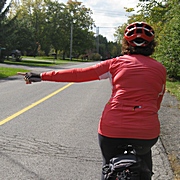 Turning left. Fully extend left arm horizontally. |
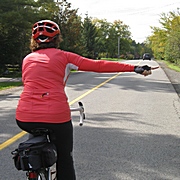 Turning right. Fully extend right arm horizontally. (Note the alternative signal below for turning right.) |
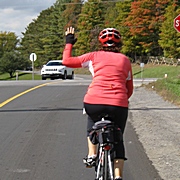 Turning right (alternative). Extend left arm out with the forearm pointing upwards (with a 90 degree bend at the elbow). This is the way motorists used to indicate a right turn before the advent of signal lights, and this hand signal is still valid today. |
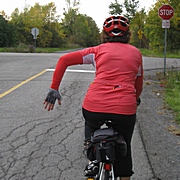 Stopping (and slowing). Extend left arm out with the forearm pointing down (with close to a 90 degree bend at the elbow), and an open palm facing aft. In practice, many people make this signal with very little bend at the elbow. |
 Road Hazard. Left or right arm extended down (usually at about 45 degrees) to point out any road hazard. Most of time this is a serious pothole, a dangerous crack in the pavement, or treacherous sewer cover. It should also be used to point out other hazardous debris, including broken glass. Road Hazard. Left or right arm extended down (usually at about 45 degrees) to point out any road hazard. Most of time this is a serious pothole, a dangerous crack in the pavement, or treacherous sewer cover. It should also be used to point out other hazardous debris, including broken glass. |
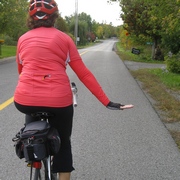 Loose gravel. Arm extended down at about 45 degrees with open palm facing down with a slight waving action means that there is loose gravel (or sand) on the road that requires caution. |
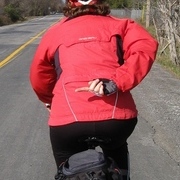 Move over. Hand behind back pointing in one direction, with a slight back and forth motion, means move over (usually because of some obstruction such as a parked car). Signal can also be made with an open hand (as if sweeping to one side). |
[feather_share]
